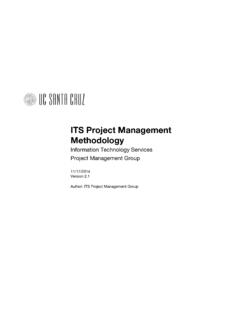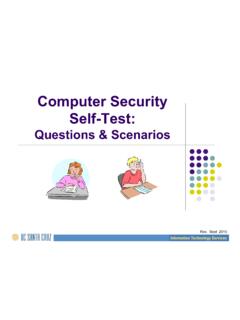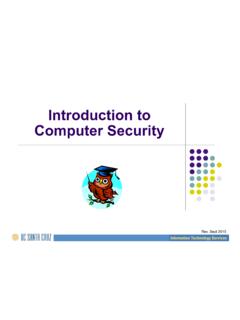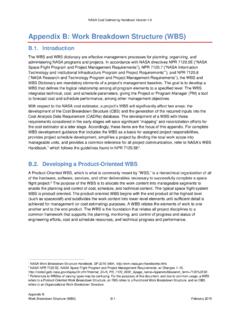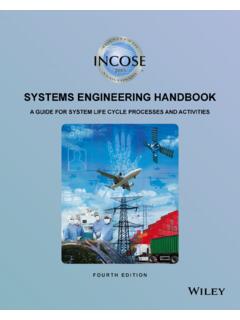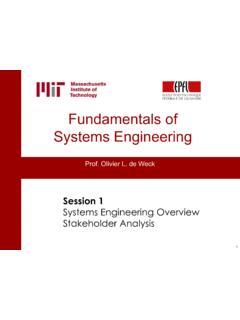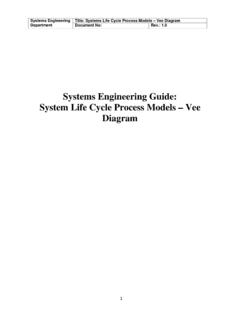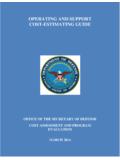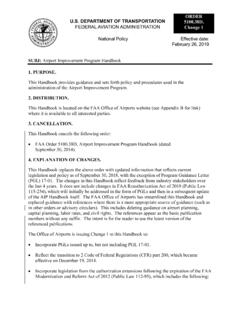Transcription of Systems Development Life Cycle (SDLC) Methodology
1 Systems Development life Cycle (SDLC) Methodology Information Technology Services July 7, 2009 Version 1 Authors: Mel Barracliffe, Lisa Gardner, John Hammond, and Shawn Duncan UC Santa Cruz Systems Development life Cycle (SDLC) Methodology ii Document Control Change Record Date Author Version Change Reference Reviewers Sign Off Date Reviewer Position Sign Off Distribution Copy Number Name UC Santa Cruz Systems Development life Cycle (SDLC) Methodology iii Table of Contents DOCUMENT CONTROL .. II Change Record .. ii Reviewers ii Distribution .. ii TABLE OF CONTENTS .. III 1. INTRODUCTION .. 7 Methodology Work Breakdown Structure (WBS) .. 8 Standard Methodology Deliverables .. 11 Methodology Roles and Responsibilities.
2 12 2. PROBLEM AND HIGH-LEVEL SOLUTION DEFINITION .. 14 Phase Goals .. 14 Phase Outputs .. 14 Phase WBS .. 15 Understand Customer Need .. 15 Evaluate Initial Customer Request .. 15 Select and Mobilize ITS Consulting Team .. 16 Consult with Customer .. 16 Develop Problem/Opportunity Statement .. 17 Define High-Level Requirements .. 17 Confirm Purpose, Goals and Benefits .. 17 Define Development Objectives and Deliverables .. 17 Define Development Approach and Methodology .. 17 Prepare High Level Requirements Document .. 17 Develop Candidate Solution Options .. 18 Evaluate Existing IT Inventory .. 18 Scan for External Solution Options .. 18 Document Candidate Solution Options .. 18 Conduct Preliminary Design Review .. 18 Review Solution Options with Sponsors.
3 18 Conduct Preliminary System Scope .. 18 Estimate Development Resources Required .. 18 Develop Rough Order of Magnitude (ROM) Development Budget .. 18 Develop Cost/Benefit Analysis .. 19 Create Preliminary Solution Scope Document .. 19 UC Santa Cruz Systems Development life Cycle (SDLC) Methodology iv Confirm Preliminary Solution Scope with Sponsors .. 19 3. REQUIREMENTS DEFINITION .. 20 Phase Goals .. 20 Phase Outputs .. 20 Phase WBS .. 21 Define Functional Requirements .. 21 Confirm User Subject Matter Experts for Requirements Definition .. 22 Develop Solution Context Diagram .. 23 Develop Process Model .. 23 Develop High-Level Data Model .. 23 Develop Use Cases .. 23 Document Functional Requirements .. 23 Define Non-Functional Requirements.
4 24 Identify Solution Technology Platform Requirements .. 24 Evaluate Technology Vendor (COTS) .. 24 Define Quality, Reliability, Availability, Service Level Needs .. 24 Define Performance Needs .. 24 Identify Security, Legal, Regulatory and Compliance Needs .. 24 Identify IT Budget Constraints on Solution .. 24 Document Non-Functional Requirements .. 25 Conduct Existing Solution Inventory and Gap Analysis .. 25 Map Existing Solutions to Requirements .. 25 Identify Solution Functional Gaps .. 25 Develop Strategies to Address Solution Gaps .. 25 Define Solution Gap Requirements .. 25 Specify Requirements .. 25 Compile Requirements .. 25 Assess and Rank Requirements .. 25 Group and Phase Requirements for 26 Publish Requirements Specification .. 26 Obtain Sign-Off of Requirements.
5 26 Conduct Requirements Review with Sponsors .. 26 Address Requirements Review Issues .. 26 Obtain Sponsor Approval of Requirements .. 26 4. SYSTEM DESIGN .. 27 Phase Goals .. 27 Phase Outputs .. 27 Phase WBS .. 28 Develop System Design .. 28 Research and Develop System Design Options .. 28 Conduct System Build/Buy Analysis .. 30 Review System Design Options with Key Stakeholders .. 30 Prepare Critical Design Review Package .. 30 UC Santa Cruz Systems Development life Cycle (SDLC) Methodology v Conduct Critical Design Review .. 30 Review System Design Options .. 30 Check System Design Alignment with EA Standards .. 31 Refine System Design and Approach .. 31 Obtain Design Review Board Approval .. 31 Develop System Quality Plan .. 32 Establish Quality Targets with Customer.
6 32 Select Quality Management Approach .. 32 Confirm ITS and Customer Quality Management Roles .. 33 Estimate System Total Cost of Ownership (TCO) .. 33 Estimate System Development Costs .. 33 Estimate System Annual Operating Support Costs .. 34 Develop System TCO Budget .. 34 Obtain Sponsor Approval For Build Phase .. 34 Review System Design & Budget with Sponsor .. 34 Incorporate Sponsor Design Review Changes .. 34 Obtain Sponsor Approval .. 35 5. SYSTEM BUILD .. 36 Phase Goals .. 36 Phase Outputs .. 36 Phase WBS .. 37 System Configuration .. 38 Acquire System Components .. 38 Develop & Configure System .. 38 Conduct Unit and System Component Tests .. 39 Assemble System Build .. 39 Address System Build Defects .. 39 Conduct Build Review.
7 39 Request and Prepare for Design Review .. 40 Tailor Design Review Checklist .. 40 Conduct System Test .. 40 Design System Test .. 40 Conduct System Test .. 40 Address System Test Solution Defects .. 40 Obtain User Acceptance of System .. 41 Design User Acceptance Test .. 41 Conduct User Acceptance Test .. 41 Obtain User Acceptance Sign-Off .. 41 6. SYSTEM DEPLOYMENT .. 42 Phase Goals .. 42 Phase Outputs .. 42 Phase WBS .. 43 Develop Operational Support Plan .. 43 UC Santa Cruz Systems Development life Cycle (SDLC) Methodology vi Document System Operational Support Needs .. 44 Identify Operational Support Team .. 44 Assign Operational Support Roles & Duties .. 44 Finalize Service Level Agreements (SLA) .. 44 Finalize Operating Level Agreements (OLA).
8 45 Document Operational Support Plan .. 45 Prepare Help Desk for System Deployment .. 45 Develop Legacy Retirement Plan .. 45 Assess Legacy Systems Impact .. 45 Build Legacy Retirement 45 Develop System Deployment 45 Assess Organizational Change Management (OCM) Impact .. 45 Define Training Approach .. 46 Design Training Curriculum .. 46 Develop Training Materials .. 46 Develop Communication Plan .. 46 Build System Deployment Plan .. 46 Conduct Operational Readiness Review (ORR) .. 47 Collect ORR Prerequisites and Inputs .. 47 Prepare ORR Review Packet .. 47 Review ORR Packet and Complete Checklist .. 47 Develop Risk Assessment & Mitigation Plan .. 47 Review Assessments & Checklist with Authors .. 47 Conduct ORR Meeting .. 47 Prepare Summary Assessment.
9 47 Deploy Solution .. 47 Notify Change Management .. 47 Stage Solution into Production Environment .. 48 Deliver End User 48 Go Live .. 48 Retire Legacy Systems .. 48 7. APPENDIX A RACI MATRICES .. 49 Page 7 of 62 1. Introduction ITS provides a spectrum of information technology (IT) resources and services that support the instruction, research, administrative operations, and public service of the University We provide information technology solutions to students, faculty and staff in the areas of: o Instructional computing o Administrative computing o Voice and data services o Information Systems security o Web services o Media services o Technical support and training The successful provision of these IT solutions to the campus requires close cooperation between multiple groups and roles within ITS.
10 In particular, the partnership between Applications and Project Management and Core Technologies is most critical in designing, building and implementing solutions that meet the needs of the campus and that are cost effective to maintain and evolve. The degree of collaboration and integration of work effort required for successful Systems delivery does not happen by accident it must be deliberately designed and managed with diligence. The process of Systems Development must be agreed to and prescribed, roles and responsibilities defined, handoffs engineered, and deliverables properly specified to ensure smooth transitions at each stage of Development . The primary reasons for using a Methodology are: ! Improve Systems Development productivity ! Improve quality of the system delivered !
